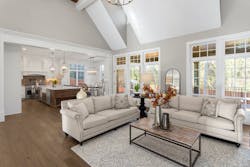Is This the End of the Open Floor Plan?
Working from home during the pandemic has exposed some of the open floor plan’s major design flaws: The trendy layout is noisy, hard to have privacy in, and expensive to maintain. But designers disagree on whether they will be gone for good or are here to stay now that Americans are spending more time in the home, according to Realtor.com. Either way, designers agree that working from home will change some aspects of the home, even if homebuyers purchase a home with an open layout. Home offices, gyms, and hybrid spaces may become hot commodities post-pandemic.
For those stuck working at home during the pandemic, we've seen the struggles. Lackluster lighting, bad backdrops, and subpar sound have all become staples of our day-to-day work lives.
One unspoken contributing factor to our ongoing work-life battle? The ubiquitous open floor plan in homes.
It's a design trend that's dominated residential real estate over the past few years. Turn on HGTV, and you'll likely see a show extolling the virtues of a space unencumbered by walls and an interior that flows seamlessly from one space to another.
